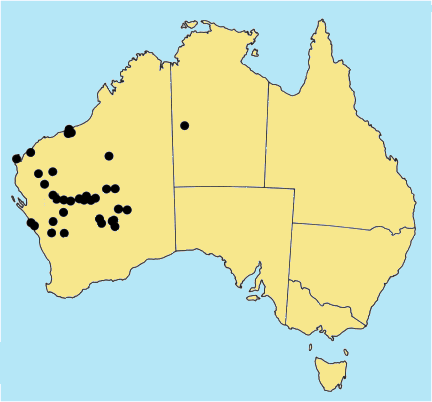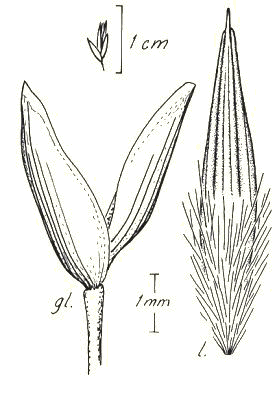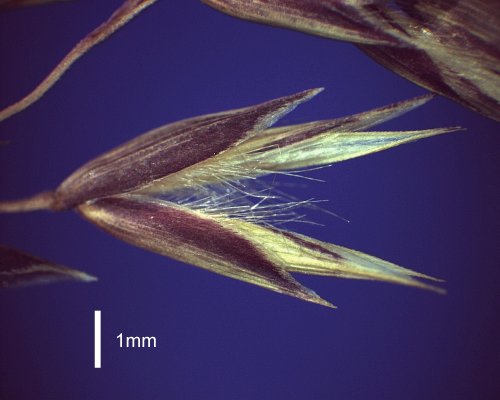Eriachne flaccida Hartley. J. Linn. Soc., Bot. 52: 346 (1942).
Classification. (GPWG 2001) : Subfamily Micrairoideae. Eriachneae.
Type of Basionym or
Protologue Information: HT: Helms s.n., 1899, Australia: Western
Australia: Eremean Province: Pindinni, 70 mi ENE of Menzies (K; IT: B, PERTH).
Key references
(books and floras): [1952] C.A.Gardner, Flora of Western Australia 1
Gramineae (50), [1981] M.Lazarides in J.Jessop (ed)., Flora of
Central Australia (442), [2002] D.Sharp & B.K.Simon, AusGrass,
Grasses of Australia.
Habit.
Perennial. Culms erect, 7–50 cm tall, 1–3 -noded. Mid-culm internodes glabrous.
Mid-culm nodes glabrous or pubescent. Lateral branches simple. Leaf-sheaths
glabrous on surface. Ligule a fringe of hairs. Leaf-blades curved or flexuous,
involute, 8–20 cm long, 1–2.5 mm wide. Leaf-blade surface smooth or
scaberulous, glabrous.
Inflorescence.
Inflorescence compound, a panicle. Panicle elliptic, 4–6(–10) cm long,
1–2(–3.5) cm wide.
Spikelets.
Spikelets pedicelled. Fertile spikelets 2-flowered, both fertile, comprising 2
fertile floret(s), without rachilla extension, ovate, laterally compressed,
5–6.5 mm long.
Glumes.
Glumes similar, thinner than fertile lemma. Lower glume ovate, membranous, much
thinner on margins, without keels, 9–11 -nerved. Lower glume surface glabrous.
Lower glume apex muticous or mucronate. Upper glume ovate, 3.5–4.5(–7) mm long,
membranous, without keels, 9–11 -nerved. Upper glume surface smooth, glabrous.
Upper glume apex muticous or mucronate.
Florets.
Fertile lemma 5–8 mm long, without keel, 5–7 -nerved. Lemma surface indumented.
Lemma apex muticous or mucronate. Median (principal) awn 2 mm long overall.
Palea apex erose or dentate. Grain 1.3–2 mm long.
Continental
Distribution: Australasia.
Australian
Distribution: Western Australia, Northern Territory.
Western Australia:
Keartland, Fortescue, Ashburton, Austin. Irwin. Northern Territory:
Central Australia North.
Notes.
This species is characterised by a combination of features, viz. compact leafy
habit, simple few-noded culms, thickened hairy base, glabrous and smooth culms,
foliage and glumes, floret longer than glume with divergent lemma and palea,
and long-acuminate lanceolate bisulcate lemma. The vesicular blades is a
distinctive character shared with a few species including the allied E.
ovata and E. benthamii. A series of intermediate forms, possibly
putative hybrids, with E. ovata occur in areas where their distributions
overlap. However, in its typical condition E. ovata is a smaller plant
with shorter, broader panicles and larger spikelets, while E. benthamii
is more robust with usually flat blades, larger spikelets and longer panicles,
and differs markedly in its ecology.
Endemic.
Arid W.A. and N.T. Seasonally wet areas such as claypans, soaks, depressions,
the banks and gravelly beds of creeks, the margins of swamps and waterholes,
streamlines, calcrete flats, and soils of sandy clays and loams. In W.A., E.
flaccida is ecologically sympatric with the closely allied E. ovata,
but extends further north. Flowers and fruits Mar.-May (autumn), July and Sept.
(mid-winter and early-spring).





